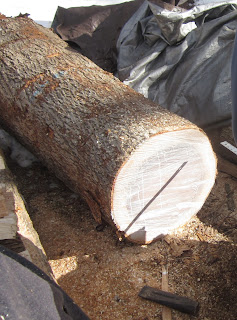I finally got around to completing my glueless continuous arm. I must say, assembly without glue is rather painless. Building the chair wasn't wildly different from my normal procedure, but it did shift my awareness about the joinery and push me to think a bit differently.
With most through tenons, such as the spindles, it's easy enough to slightly shoulder the tenon so that the arm can't slide down any further and then to oval the mortise at exit so that the wedge distorts the tenon and locks it in place. It's a version of the hammer eye joint, with it's hourglass shape that holds hammer heads in on their handles.
Tapered tenons, such as on the ends of the legs don't present a problem because the weight of the sitter in use keeps them tight. But the tapers at the top and bottom of the armposts have more complex stresses and the glueless chair got me to thinking about my approach to them.
This is where our flat friends come in. When wedging a rectangular tenon
in a through mortise, the practice is to flare the mortise and use 2
wedges close to the edges of the tenon to distort the tenon to fill the
flare.
The usual approach when making a chair is to use a single wedge in the middle, which adds pressure to the fit of the joint, but doesn't create a distinct flare, at least not enough to create a "lock".
So with my glueless chair, I flared the opening where the tenon comes out of the mortise to create the hourglass shape and used two wedges to lock it in place.
You can see here that the tenon, although tapered, easily flared outward to create a "lock"
Here is the top after cutting the tenon flush.
I must say, even though time will be the real judge, I have a lot of confidence that this joint ain't goin nowhere. As I move on into glued chairs, I am definitely taking some lessons learned making this one, now where's that blue paint?
If you'd like to spend a couple of days with me on March 9th and 10th while I demonstrate building this chair, check out the website at the
Connecticut Valley School of Woodworking for details.
Here is a pic of Nick Clayton with his recently completed comb back. Nick lives nearby and was able to come to class periodically over a couple of months.
I think that the quality of the chair benefited from the extra time and relaxed approach we took. Either that or the kid's a natural! It's one of the nicest comb backs I've seen, well done Nick.










